Business Law Report: Unit 7 - Legal System and Impact
VerifiedAdded on 2023/01/18
|12
|4291
|78
Report
AI Summary
This report, focusing on Unit 7 of a Business Law course, provides a comprehensive overview of the legal system and its impact on businesses. It delves into the nature of the legal system, exploring different sources of law such as constitutional, statutory, treaties, administrative regulations, and common law. The report examines the role of government in lawmaking, differentiating between statutory and common law and their application in justice courts. It illustrates the potential impact of company, employment, and contract law on businesses, supported by specific examples. Additionally, it explores the legal formation, management, and funding of various business organizations. The report concludes by recommending appropriate legal solutions for resolving a range of disputes, providing practical examples to demonstrate the application of legal principles.
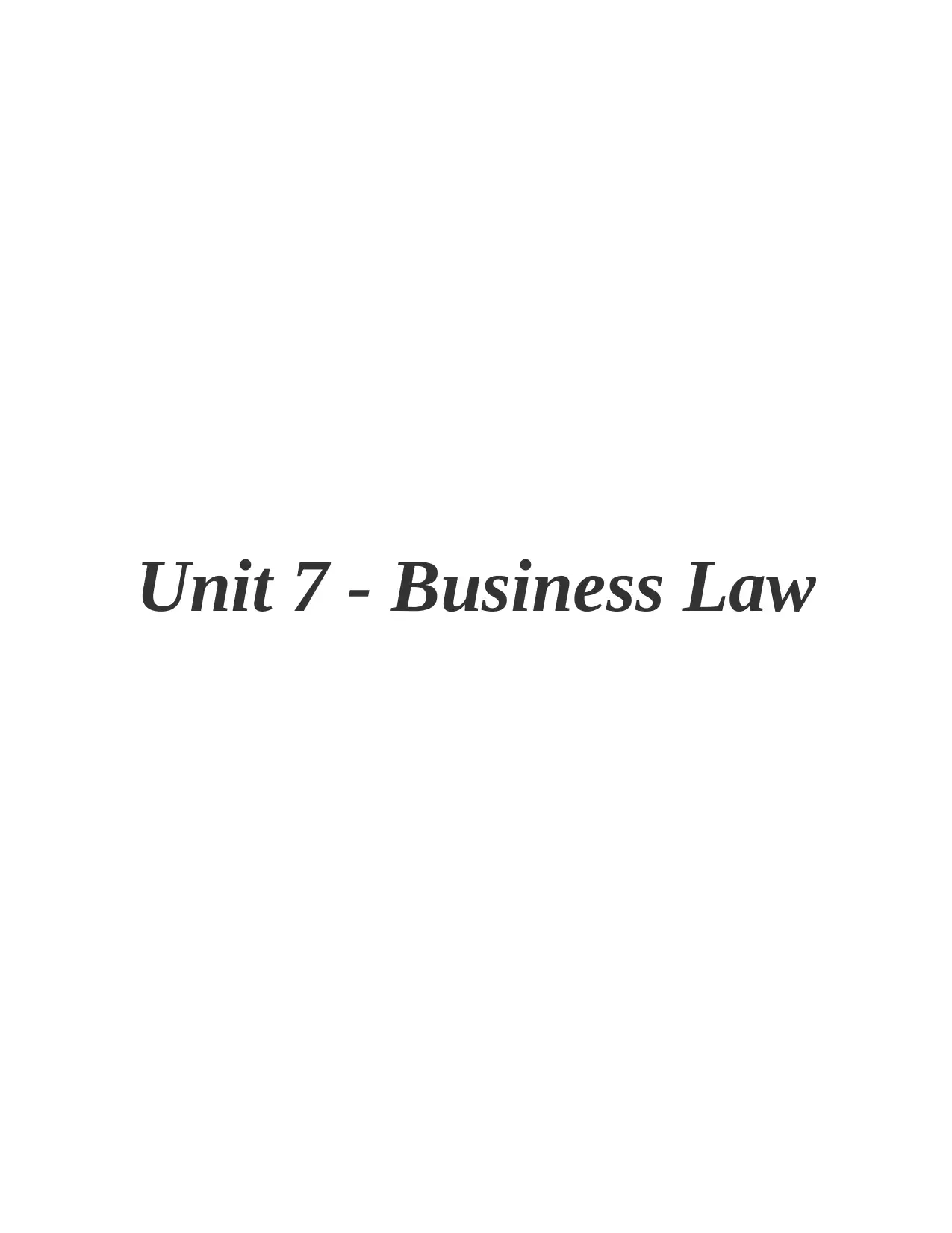
Unit 7 - Business Law
Paraphrase This Document
Need a fresh take? Get an instant paraphrase of this document with our AI Paraphraser
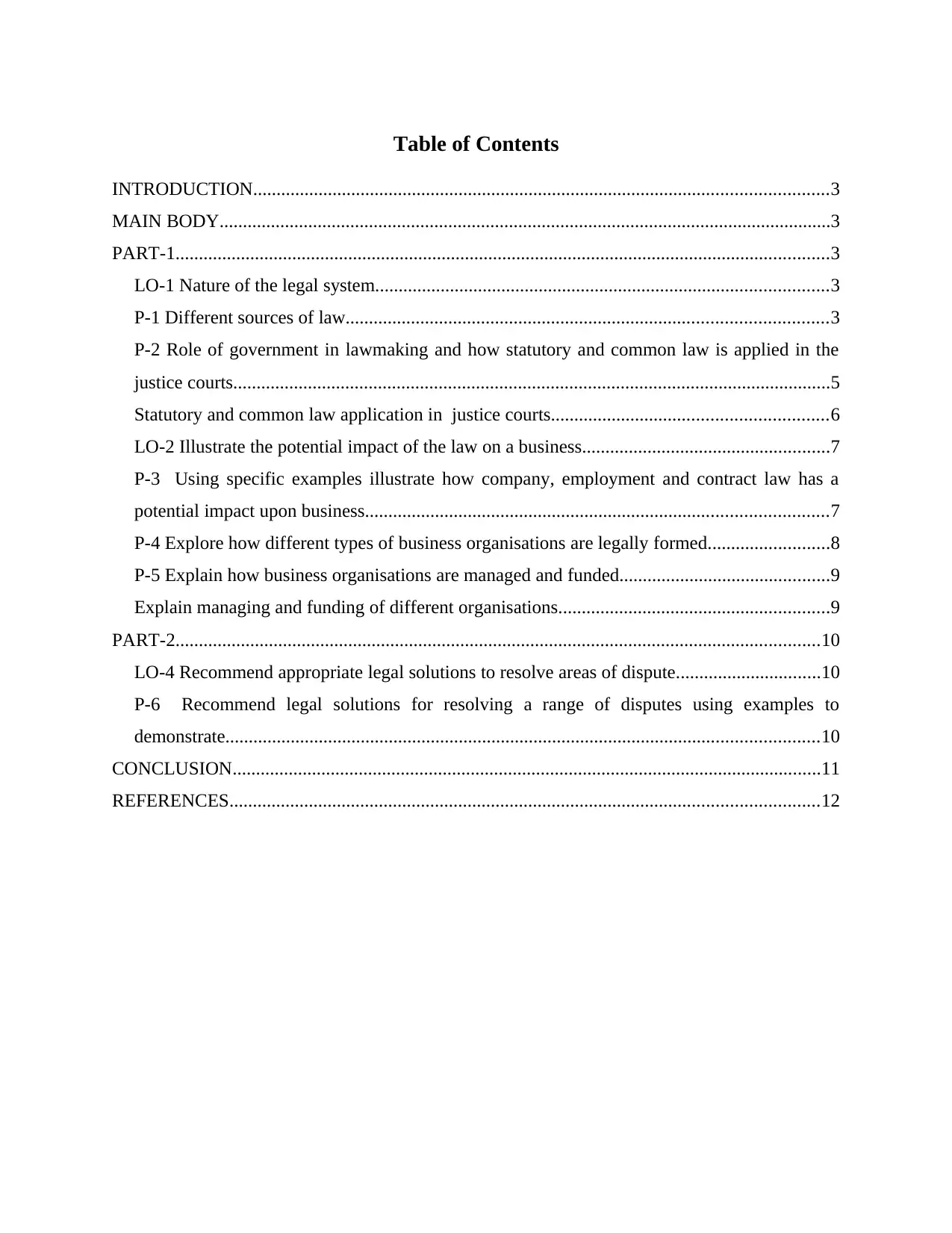
Table of Contents
INTRODUCTION...........................................................................................................................3
MAIN BODY...................................................................................................................................3
PART-1............................................................................................................................................3
LO-1 Nature of the legal system.................................................................................................3
P-1 Different sources of law.......................................................................................................3
P-2 Role of government in lawmaking and how statutory and common law is applied in the
justice courts................................................................................................................................5
Statutory and common law application in justice courts...........................................................6
LO-2 Illustrate the potential impact of the law on a business.....................................................7
P-3 Using specific examples illustrate how company, employment and contract law has a
potential impact upon business...................................................................................................7
P-4 Explore how different types of business organisations are legally formed..........................8
P-5 Explain how business organisations are managed and funded.............................................9
Explain managing and funding of different organisations..........................................................9
PART-2..........................................................................................................................................10
LO-4 Recommend appropriate legal solutions to resolve areas of dispute...............................10
P-6 Recommend legal solutions for resolving a range of disputes using examples to
demonstrate...............................................................................................................................10
CONCLUSION..............................................................................................................................11
REFERENCES..............................................................................................................................12
INTRODUCTION...........................................................................................................................3
MAIN BODY...................................................................................................................................3
PART-1............................................................................................................................................3
LO-1 Nature of the legal system.................................................................................................3
P-1 Different sources of law.......................................................................................................3
P-2 Role of government in lawmaking and how statutory and common law is applied in the
justice courts................................................................................................................................5
Statutory and common law application in justice courts...........................................................6
LO-2 Illustrate the potential impact of the law on a business.....................................................7
P-3 Using specific examples illustrate how company, employment and contract law has a
potential impact upon business...................................................................................................7
P-4 Explore how different types of business organisations are legally formed..........................8
P-5 Explain how business organisations are managed and funded.............................................9
Explain managing and funding of different organisations..........................................................9
PART-2..........................................................................................................................................10
LO-4 Recommend appropriate legal solutions to resolve areas of dispute...............................10
P-6 Recommend legal solutions for resolving a range of disputes using examples to
demonstrate...............................................................................................................................10
CONCLUSION..............................................................................................................................11
REFERENCES..............................................................................................................................12
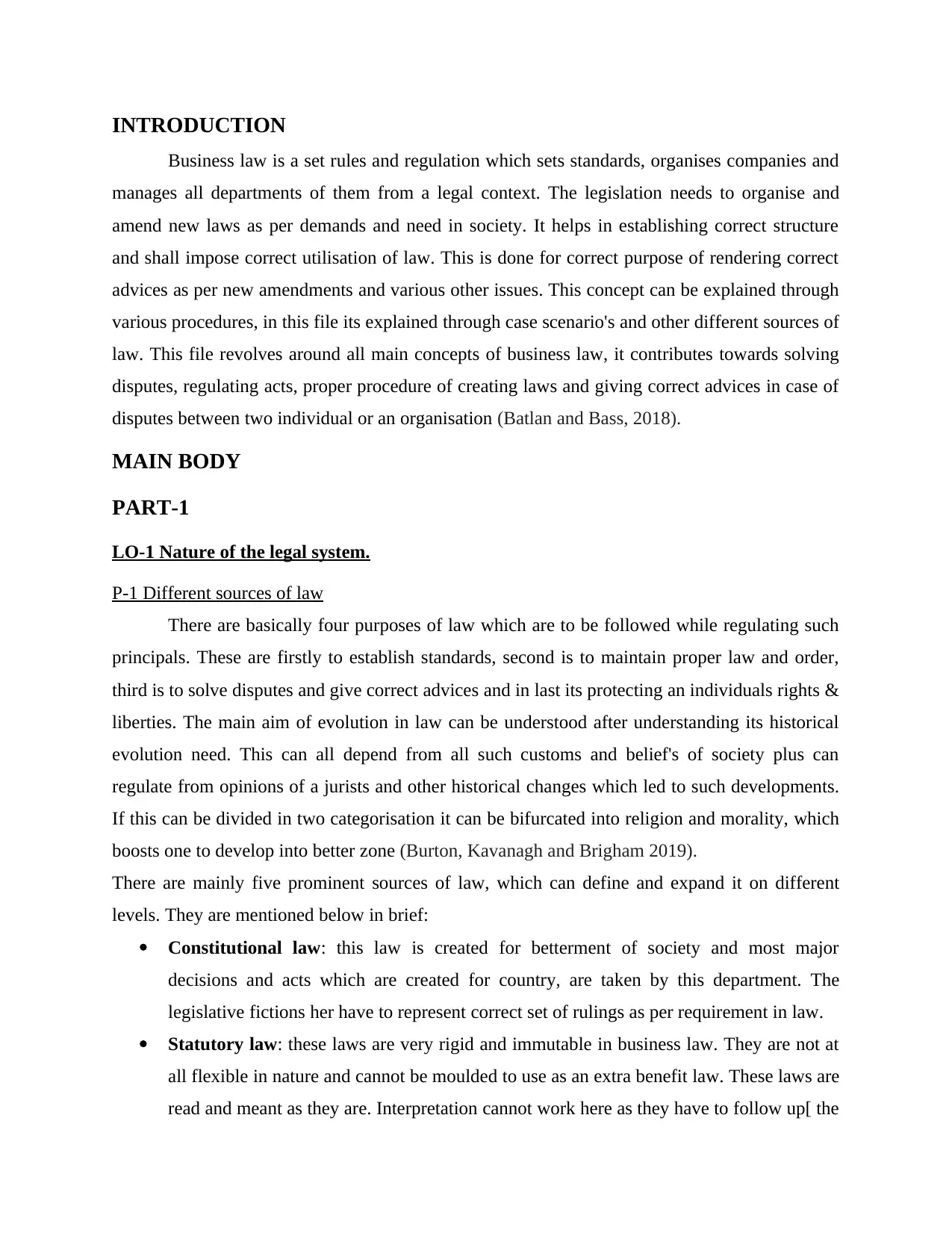
INTRODUCTION
Business law is a set rules and regulation which sets standards, organises companies and
manages all departments of them from a legal context. The legislation needs to organise and
amend new laws as per demands and need in society. It helps in establishing correct structure
and shall impose correct utilisation of law. This is done for correct purpose of rendering correct
advices as per new amendments and various other issues. This concept can be explained through
various procedures, in this file its explained through case scenario's and other different sources of
law. This file revolves around all main concepts of business law, it contributes towards solving
disputes, regulating acts, proper procedure of creating laws and giving correct advices in case of
disputes between two individual or an organisation (Batlan and Bass, 2018).
MAIN BODY
PART-1
LO-1 Nature of the legal system.
P-1 Different sources of law
There are basically four purposes of law which are to be followed while regulating such
principals. These are firstly to establish standards, second is to maintain proper law and order,
third is to solve disputes and give correct advices and in last its protecting an individuals rights &
liberties. The main aim of evolution in law can be understood after understanding its historical
evolution need. This can all depend from all such customs and belief's of society plus can
regulate from opinions of a jurists and other historical changes which led to such developments.
If this can be divided in two categorisation it can be bifurcated into religion and morality, which
boosts one to develop into better zone (Burton, Kavanagh and Brigham 2019).
There are mainly five prominent sources of law, which can define and expand it on different
levels. They are mentioned below in brief:
Constitutional law: this law is created for betterment of society and most major
decisions and acts which are created for country, are taken by this department. The
legislative fictions her have to represent correct set of rulings as per requirement in law.
Statutory law: these laws are very rigid and immutable in business law. They are not at
all flexible in nature and cannot be moulded to use as an extra benefit law. These laws are
read and meant as they are. Interpretation cannot work here as they have to follow up[ the
Business law is a set rules and regulation which sets standards, organises companies and
manages all departments of them from a legal context. The legislation needs to organise and
amend new laws as per demands and need in society. It helps in establishing correct structure
and shall impose correct utilisation of law. This is done for correct purpose of rendering correct
advices as per new amendments and various other issues. This concept can be explained through
various procedures, in this file its explained through case scenario's and other different sources of
law. This file revolves around all main concepts of business law, it contributes towards solving
disputes, regulating acts, proper procedure of creating laws and giving correct advices in case of
disputes between two individual or an organisation (Batlan and Bass, 2018).
MAIN BODY
PART-1
LO-1 Nature of the legal system.
P-1 Different sources of law
There are basically four purposes of law which are to be followed while regulating such
principals. These are firstly to establish standards, second is to maintain proper law and order,
third is to solve disputes and give correct advices and in last its protecting an individuals rights &
liberties. The main aim of evolution in law can be understood after understanding its historical
evolution need. This can all depend from all such customs and belief's of society plus can
regulate from opinions of a jurists and other historical changes which led to such developments.
If this can be divided in two categorisation it can be bifurcated into religion and morality, which
boosts one to develop into better zone (Burton, Kavanagh and Brigham 2019).
There are mainly five prominent sources of law, which can define and expand it on different
levels. They are mentioned below in brief:
Constitutional law: this law is created for betterment of society and most major
decisions and acts which are created for country, are taken by this department. The
legislative fictions her have to represent correct set of rulings as per requirement in law.
Statutory law: these laws are very rigid and immutable in business law. They are not at
all flexible in nature and cannot be moulded to use as an extra benefit law. These laws are
read and meant as they are. Interpretation cannot work here as they have to follow up[ the
⊘ This is a preview!⊘
Do you want full access?
Subscribe today to unlock all pages.

Trusted by 1+ million students worldwide
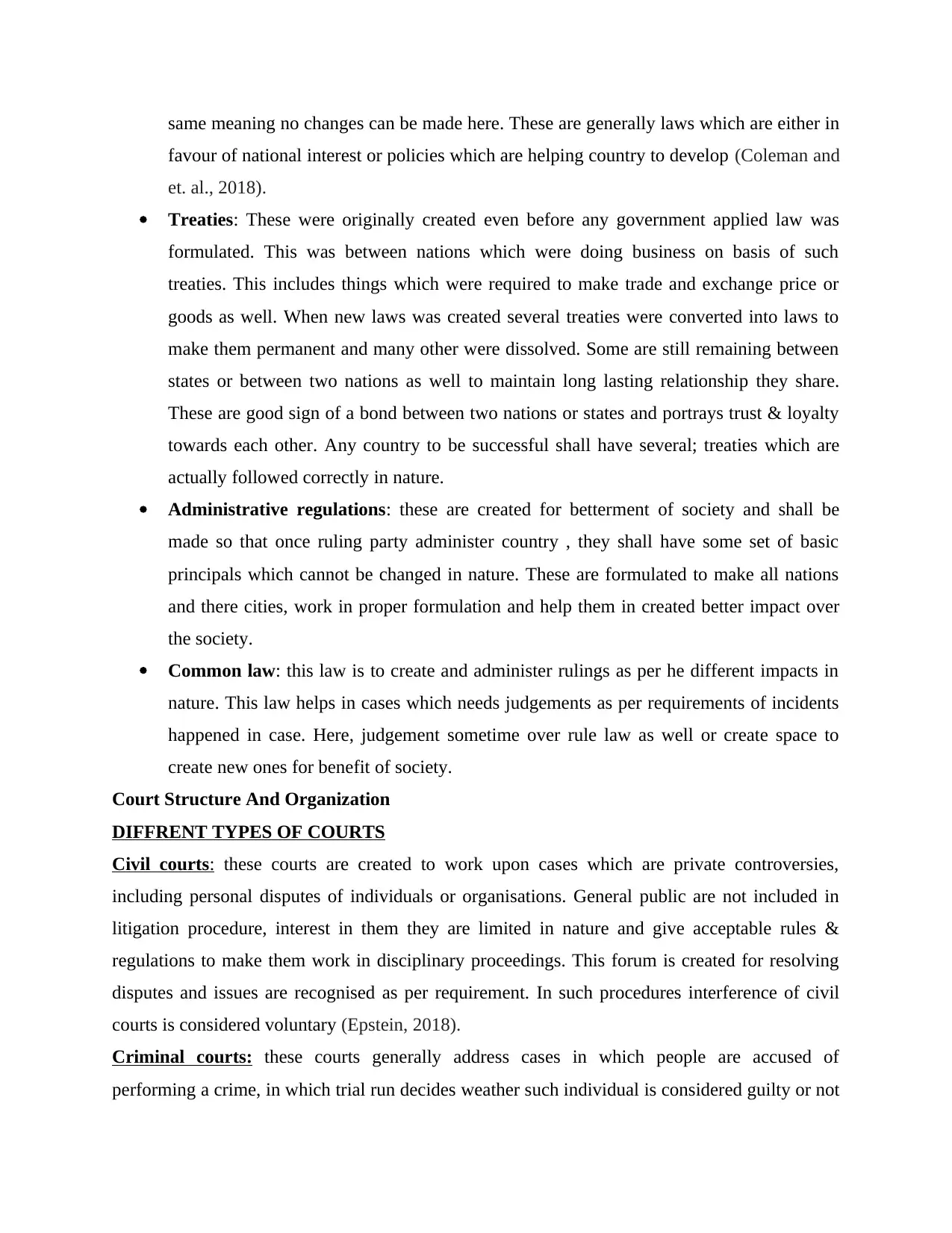
same meaning no changes can be made here. These are generally laws which are either in
favour of national interest or policies which are helping country to develop (Coleman and
et. al., 2018).
Treaties: These were originally created even before any government applied law was
formulated. This was between nations which were doing business on basis of such
treaties. This includes things which were required to make trade and exchange price or
goods as well. When new laws was created several treaties were converted into laws to
make them permanent and many other were dissolved. Some are still remaining between
states or between two nations as well to maintain long lasting relationship they share.
These are good sign of a bond between two nations or states and portrays trust & loyalty
towards each other. Any country to be successful shall have several; treaties which are
actually followed correctly in nature.
Administrative regulations: these are created for betterment of society and shall be
made so that once ruling party administer country , they shall have some set of basic
principals which cannot be changed in nature. These are formulated to make all nations
and there cities, work in proper formulation and help them in created better impact over
the society.
Common law: this law is to create and administer rulings as per he different impacts in
nature. This law helps in cases which needs judgements as per requirements of incidents
happened in case. Here, judgement sometime over rule law as well or create space to
create new ones for benefit of society.
Court Structure And Organization
DIFFRENT TYPES OF COURTS
Civil courts: these courts are created to work upon cases which are private controversies,
including personal disputes of individuals or organisations. General public are not included in
litigation procedure, interest in them they are limited in nature and give acceptable rules &
regulations to make them work in disciplinary proceedings. This forum is created for resolving
disputes and issues are recognised as per requirement. In such procedures interference of civil
courts is considered voluntary (Epstein, 2018).
Criminal courts: these courts generally address cases in which people are accused of
performing a crime, in which trial run decides weather such individual is considered guilty or not
favour of national interest or policies which are helping country to develop (Coleman and
et. al., 2018).
Treaties: These were originally created even before any government applied law was
formulated. This was between nations which were doing business on basis of such
treaties. This includes things which were required to make trade and exchange price or
goods as well. When new laws was created several treaties were converted into laws to
make them permanent and many other were dissolved. Some are still remaining between
states or between two nations as well to maintain long lasting relationship they share.
These are good sign of a bond between two nations or states and portrays trust & loyalty
towards each other. Any country to be successful shall have several; treaties which are
actually followed correctly in nature.
Administrative regulations: these are created for betterment of society and shall be
made so that once ruling party administer country , they shall have some set of basic
principals which cannot be changed in nature. These are formulated to make all nations
and there cities, work in proper formulation and help them in created better impact over
the society.
Common law: this law is to create and administer rulings as per he different impacts in
nature. This law helps in cases which needs judgements as per requirements of incidents
happened in case. Here, judgement sometime over rule law as well or create space to
create new ones for benefit of society.
Court Structure And Organization
DIFFRENT TYPES OF COURTS
Civil courts: these courts are created to work upon cases which are private controversies,
including personal disputes of individuals or organisations. General public are not included in
litigation procedure, interest in them they are limited in nature and give acceptable rules &
regulations to make them work in disciplinary proceedings. This forum is created for resolving
disputes and issues are recognised as per requirement. In such procedures interference of civil
courts is considered voluntary (Epstein, 2018).
Criminal courts: these courts generally address cases in which people are accused of
performing a crime, in which trial run decides weather such individual is considered guilty or not
Paraphrase This Document
Need a fresh take? Get an instant paraphrase of this document with our AI Paraphraser
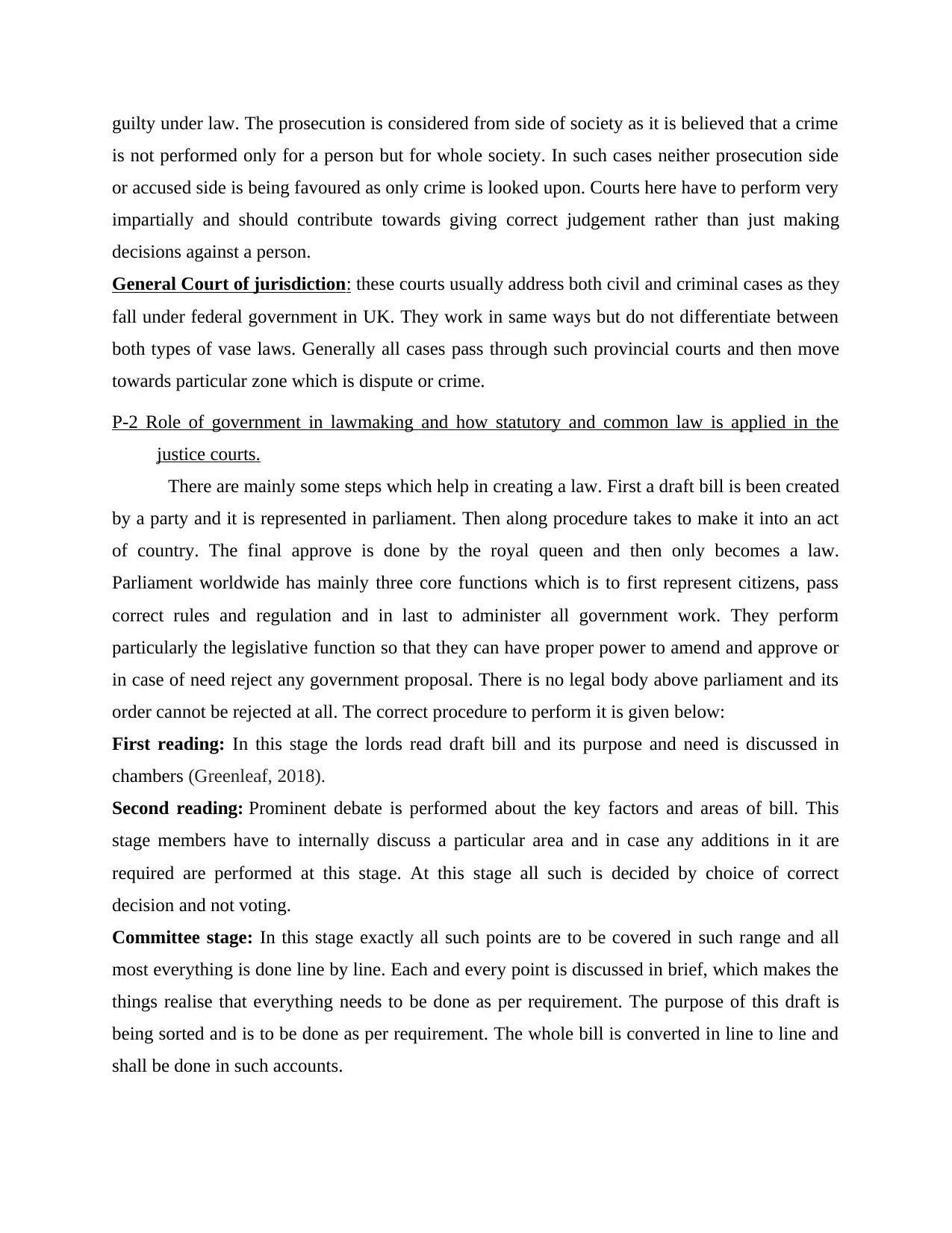
guilty under law. The prosecution is considered from side of society as it is believed that a crime
is not performed only for a person but for whole society. In such cases neither prosecution side
or accused side is being favoured as only crime is looked upon. Courts here have to perform very
impartially and should contribute towards giving correct judgement rather than just making
decisions against a person.
General Court of jurisdiction: these courts usually address both civil and criminal cases as they
fall under federal government in UK. They work in same ways but do not differentiate between
both types of vase laws. Generally all cases pass through such provincial courts and then move
towards particular zone which is dispute or crime.
P-2 Role of government in lawmaking and how statutory and common law is applied in the
justice courts.
There are mainly some steps which help in creating a law. First a draft bill is been created
by a party and it is represented in parliament. Then along procedure takes to make it into an act
of country. The final approve is done by the royal queen and then only becomes a law.
Parliament worldwide has mainly three core functions which is to first represent citizens, pass
correct rules and regulation and in last to administer all government work. They perform
particularly the legislative function so that they can have proper power to amend and approve or
in case of need reject any government proposal. There is no legal body above parliament and its
order cannot be rejected at all. The correct procedure to perform it is given below:
First reading: In this stage the lords read draft bill and its purpose and need is discussed in
chambers (Greenleaf, 2018).
Second reading: Prominent debate is performed about the key factors and areas of bill. This
stage members have to internally discuss a particular area and in case any additions in it are
required are performed at this stage. At this stage all such is decided by choice of correct
decision and not voting.
Committee stage: In this stage exactly all such points are to be covered in such range and all
most everything is done line by line. Each and every point is discussed in brief, which makes the
things realise that everything needs to be done as per requirement. The purpose of this draft is
being sorted and is to be done as per requirement. The whole bill is converted in line to line and
shall be done in such accounts.
is not performed only for a person but for whole society. In such cases neither prosecution side
or accused side is being favoured as only crime is looked upon. Courts here have to perform very
impartially and should contribute towards giving correct judgement rather than just making
decisions against a person.
General Court of jurisdiction: these courts usually address both civil and criminal cases as they
fall under federal government in UK. They work in same ways but do not differentiate between
both types of vase laws. Generally all cases pass through such provincial courts and then move
towards particular zone which is dispute or crime.
P-2 Role of government in lawmaking and how statutory and common law is applied in the
justice courts.
There are mainly some steps which help in creating a law. First a draft bill is been created
by a party and it is represented in parliament. Then along procedure takes to make it into an act
of country. The final approve is done by the royal queen and then only becomes a law.
Parliament worldwide has mainly three core functions which is to first represent citizens, pass
correct rules and regulation and in last to administer all government work. They perform
particularly the legislative function so that they can have proper power to amend and approve or
in case of need reject any government proposal. There is no legal body above parliament and its
order cannot be rejected at all. The correct procedure to perform it is given below:
First reading: In this stage the lords read draft bill and its purpose and need is discussed in
chambers (Greenleaf, 2018).
Second reading: Prominent debate is performed about the key factors and areas of bill. This
stage members have to internally discuss a particular area and in case any additions in it are
required are performed at this stage. At this stage all such is decided by choice of correct
decision and not voting.
Committee stage: In this stage exactly all such points are to be covered in such range and all
most everything is done line by line. Each and every point is discussed in brief, which makes the
things realise that everything needs to be done as per requirement. The purpose of this draft is
being sorted and is to be done as per requirement. The whole bill is converted in line to line and
shall be done in such accounts.
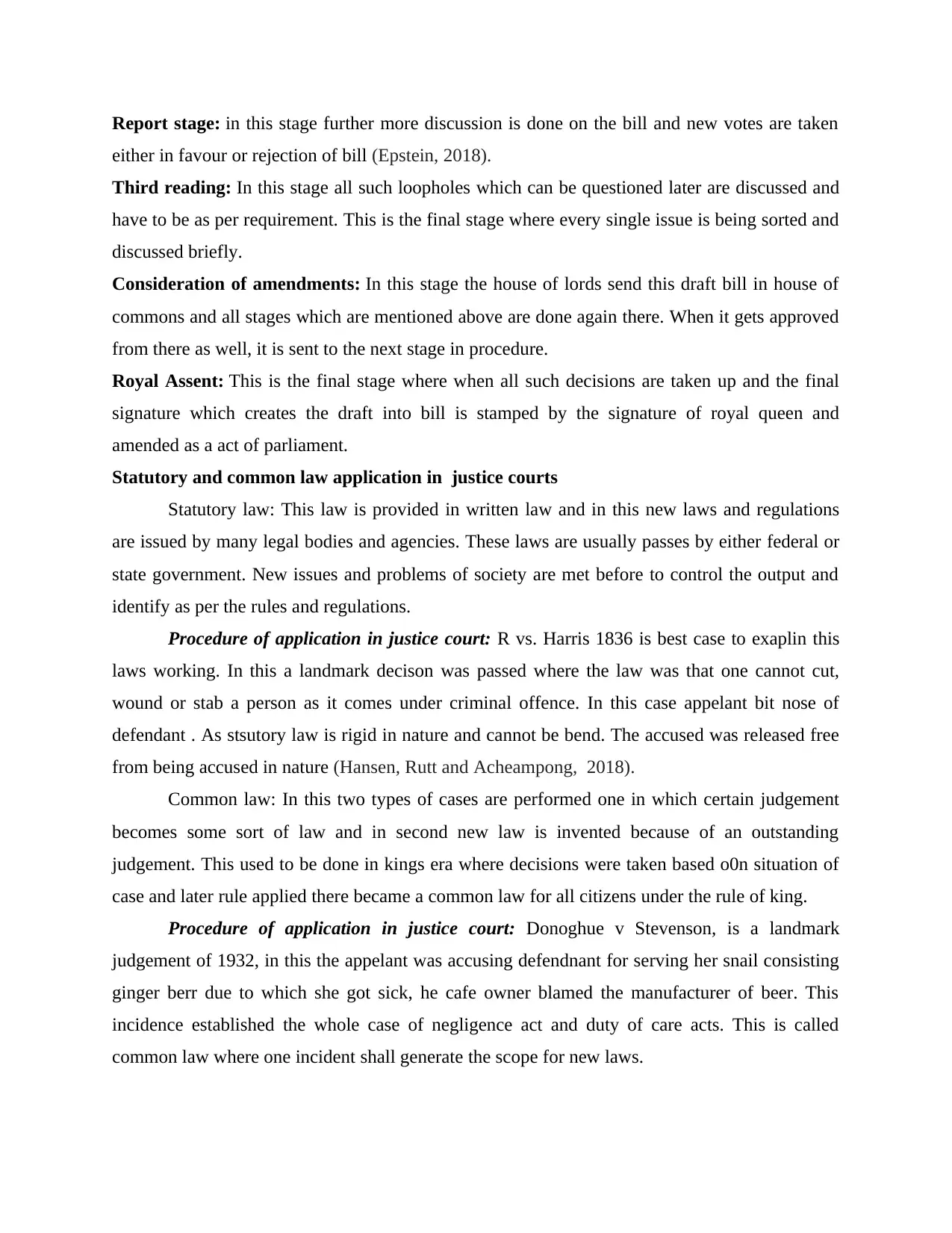
Report stage: in this stage further more discussion is done on the bill and new votes are taken
either in favour or rejection of bill (Epstein, 2018).
Third reading: In this stage all such loopholes which can be questioned later are discussed and
have to be as per requirement. This is the final stage where every single issue is being sorted and
discussed briefly.
Consideration of amendments: In this stage the house of lords send this draft bill in house of
commons and all stages which are mentioned above are done again there. When it gets approved
from there as well, it is sent to the next stage in procedure.
Royal Assent: This is the final stage where when all such decisions are taken up and the final
signature which creates the draft into bill is stamped by the signature of royal queen and
amended as a act of parliament.
Statutory and common law application in justice courts
Statutory law: This law is provided in written law and in this new laws and regulations
are issued by many legal bodies and agencies. These laws are usually passes by either federal or
state government. New issues and problems of society are met before to control the output and
identify as per the rules and regulations.
Procedure of application in justice court: R vs. Harris 1836 is best case to exaplin this
laws working. In this a landmark decison was passed where the law was that one cannot cut,
wound or stab a person as it comes under criminal offence. In this case appelant bit nose of
defendant . As stsutory law is rigid in nature and cannot be bend. The accused was released free
from being accused in nature (Hansen, Rutt and Acheampong, 2018).
Common law: In this two types of cases are performed one in which certain judgement
becomes some sort of law and in second new law is invented because of an outstanding
judgement. This used to be done in kings era where decisions were taken based o0n situation of
case and later rule applied there became a common law for all citizens under the rule of king.
Procedure of application in justice court: Donoghue v Stevenson, is a landmark
judgement of 1932, in this the appelant was accusing defendnant for serving her snail consisting
ginger berr due to which she got sick, he cafe owner blamed the manufacturer of beer. This
incidence established the whole case of negligence act and duty of care acts. This is called
common law where one incident shall generate the scope for new laws.
either in favour or rejection of bill (Epstein, 2018).
Third reading: In this stage all such loopholes which can be questioned later are discussed and
have to be as per requirement. This is the final stage where every single issue is being sorted and
discussed briefly.
Consideration of amendments: In this stage the house of lords send this draft bill in house of
commons and all stages which are mentioned above are done again there. When it gets approved
from there as well, it is sent to the next stage in procedure.
Royal Assent: This is the final stage where when all such decisions are taken up and the final
signature which creates the draft into bill is stamped by the signature of royal queen and
amended as a act of parliament.
Statutory and common law application in justice courts
Statutory law: This law is provided in written law and in this new laws and regulations
are issued by many legal bodies and agencies. These laws are usually passes by either federal or
state government. New issues and problems of society are met before to control the output and
identify as per the rules and regulations.
Procedure of application in justice court: R vs. Harris 1836 is best case to exaplin this
laws working. In this a landmark decison was passed where the law was that one cannot cut,
wound or stab a person as it comes under criminal offence. In this case appelant bit nose of
defendant . As stsutory law is rigid in nature and cannot be bend. The accused was released free
from being accused in nature (Hansen, Rutt and Acheampong, 2018).
Common law: In this two types of cases are performed one in which certain judgement
becomes some sort of law and in second new law is invented because of an outstanding
judgement. This used to be done in kings era where decisions were taken based o0n situation of
case and later rule applied there became a common law for all citizens under the rule of king.
Procedure of application in justice court: Donoghue v Stevenson, is a landmark
judgement of 1932, in this the appelant was accusing defendnant for serving her snail consisting
ginger berr due to which she got sick, he cafe owner blamed the manufacturer of beer. This
incidence established the whole case of negligence act and duty of care acts. This is called
common law where one incident shall generate the scope for new laws.
⊘ This is a preview!⊘
Do you want full access?
Subscribe today to unlock all pages.

Trusted by 1+ million students worldwide
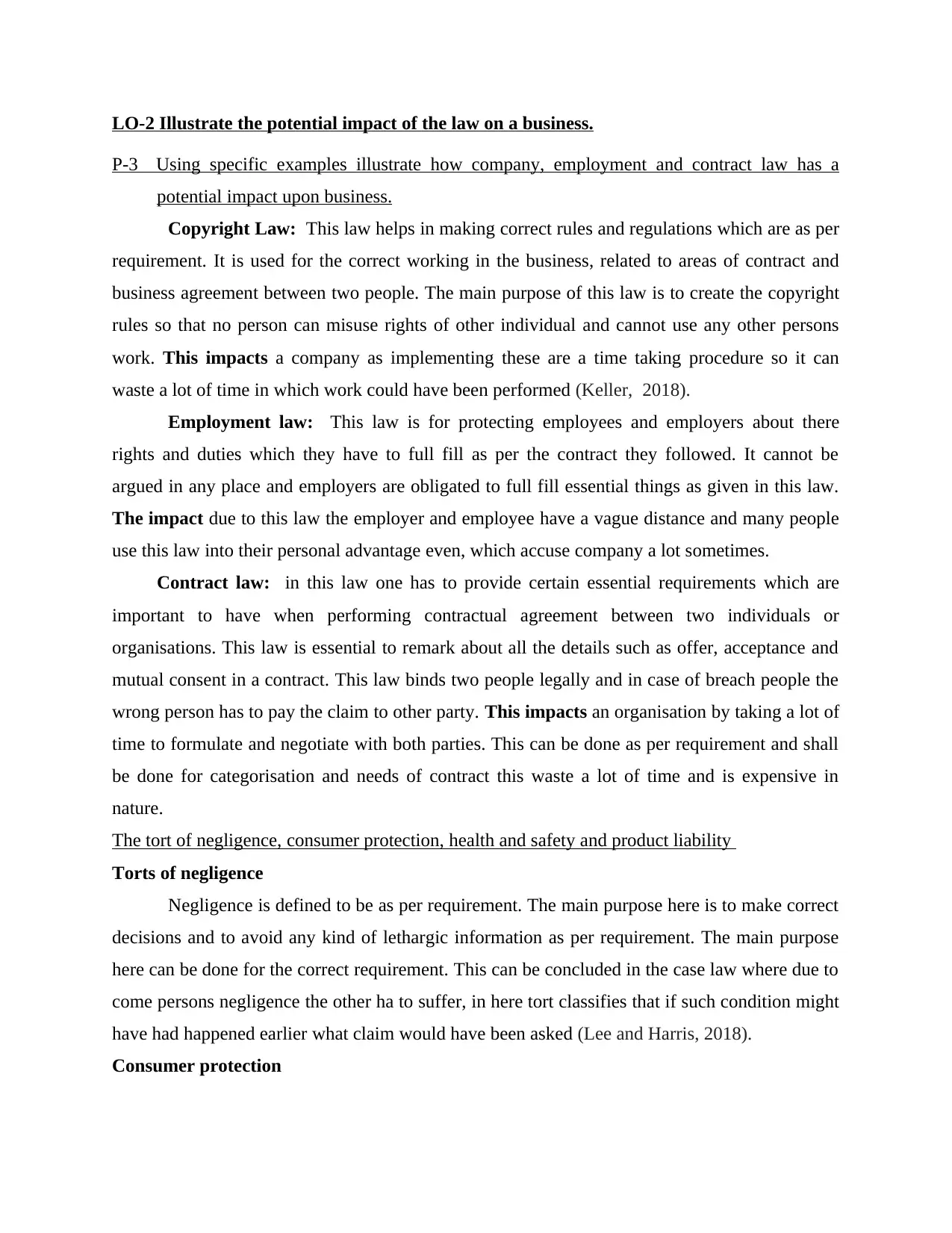
LO-2 Illustrate the potential impact of the law on a business.
P-3 Using specific examples illustrate how company, employment and contract law has a
potential impact upon business.
Copyright Law: This law helps in making correct rules and regulations which are as per
requirement. It is used for the correct working in the business, related to areas of contract and
business agreement between two people. The main purpose of this law is to create the copyright
rules so that no person can misuse rights of other individual and cannot use any other persons
work. This impacts a company as implementing these are a time taking procedure so it can
waste a lot of time in which work could have been performed (Keller, 2018).
Employment law: This law is for protecting employees and employers about there
rights and duties which they have to full fill as per the contract they followed. It cannot be
argued in any place and employers are obligated to full fill essential things as given in this law.
The impact due to this law the employer and employee have a vague distance and many people
use this law into their personal advantage even, which accuse company a lot sometimes.
Contract law: in this law one has to provide certain essential requirements which are
important to have when performing contractual agreement between two individuals or
organisations. This law is essential to remark about all the details such as offer, acceptance and
mutual consent in a contract. This law binds two people legally and in case of breach people the
wrong person has to pay the claim to other party. This impacts an organisation by taking a lot of
time to formulate and negotiate with both parties. This can be done as per requirement and shall
be done for categorisation and needs of contract this waste a lot of time and is expensive in
nature.
The tort of negligence, consumer protection, health and safety and product liability
Torts of negligence
Negligence is defined to be as per requirement. The main purpose here is to make correct
decisions and to avoid any kind of lethargic information as per requirement. The main purpose
here can be done for the correct requirement. This can be concluded in the case law where due to
come persons negligence the other ha to suffer, in here tort classifies that if such condition might
have had happened earlier what claim would have been asked (Lee and Harris, 2018).
Consumer protection
P-3 Using specific examples illustrate how company, employment and contract law has a
potential impact upon business.
Copyright Law: This law helps in making correct rules and regulations which are as per
requirement. It is used for the correct working in the business, related to areas of contract and
business agreement between two people. The main purpose of this law is to create the copyright
rules so that no person can misuse rights of other individual and cannot use any other persons
work. This impacts a company as implementing these are a time taking procedure so it can
waste a lot of time in which work could have been performed (Keller, 2018).
Employment law: This law is for protecting employees and employers about there
rights and duties which they have to full fill as per the contract they followed. It cannot be
argued in any place and employers are obligated to full fill essential things as given in this law.
The impact due to this law the employer and employee have a vague distance and many people
use this law into their personal advantage even, which accuse company a lot sometimes.
Contract law: in this law one has to provide certain essential requirements which are
important to have when performing contractual agreement between two individuals or
organisations. This law is essential to remark about all the details such as offer, acceptance and
mutual consent in a contract. This law binds two people legally and in case of breach people the
wrong person has to pay the claim to other party. This impacts an organisation by taking a lot of
time to formulate and negotiate with both parties. This can be done as per requirement and shall
be done for categorisation and needs of contract this waste a lot of time and is expensive in
nature.
The tort of negligence, consumer protection, health and safety and product liability
Torts of negligence
Negligence is defined to be as per requirement. The main purpose here is to make correct
decisions and to avoid any kind of lethargic information as per requirement. The main purpose
here can be done for the correct requirement. This can be concluded in the case law where due to
come persons negligence the other ha to suffer, in here tort classifies that if such condition might
have had happened earlier what claim would have been asked (Lee and Harris, 2018).
Consumer protection
Paraphrase This Document
Need a fresh take? Get an instant paraphrase of this document with our AI Paraphraser
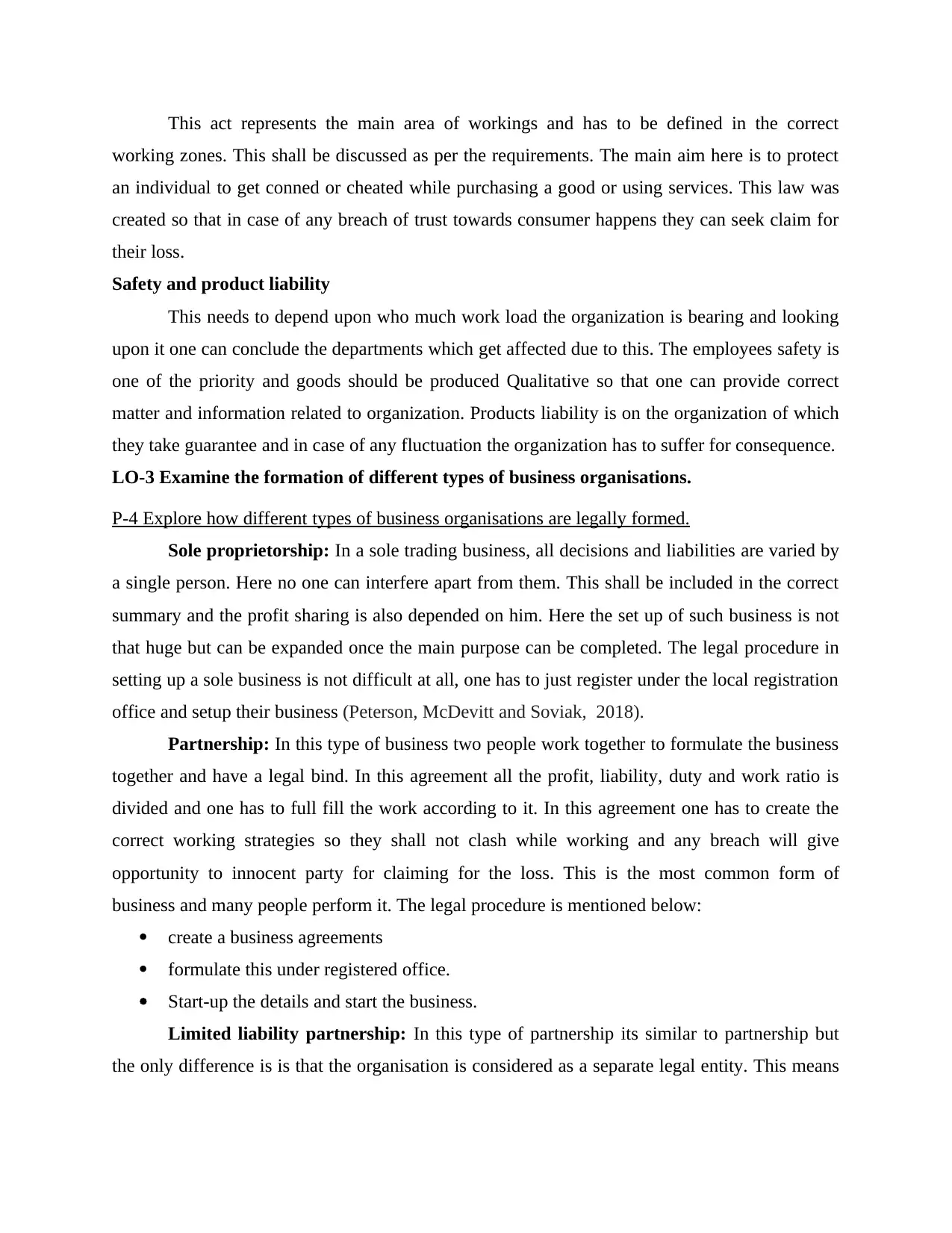
This act represents the main area of workings and has to be defined in the correct
working zones. This shall be discussed as per the requirements. The main aim here is to protect
an individual to get conned or cheated while purchasing a good or using services. This law was
created so that in case of any breach of trust towards consumer happens they can seek claim for
their loss.
Safety and product liability
This needs to depend upon who much work load the organization is bearing and looking
upon it one can conclude the departments which get affected due to this. The employees safety is
one of the priority and goods should be produced Qualitative so that one can provide correct
matter and information related to organization. Products liability is on the organization of which
they take guarantee and in case of any fluctuation the organization has to suffer for consequence.
LO-3 Examine the formation of different types of business organisations.
P-4 Explore how different types of business organisations are legally formed.
Sole proprietorship: In a sole trading business, all decisions and liabilities are varied by
a single person. Here no one can interfere apart from them. This shall be included in the correct
summary and the profit sharing is also depended on him. Here the set up of such business is not
that huge but can be expanded once the main purpose can be completed. The legal procedure in
setting up a sole business is not difficult at all, one has to just register under the local registration
office and setup their business (Peterson, McDevitt and Soviak, 2018).
Partnership: In this type of business two people work together to formulate the business
together and have a legal bind. In this agreement all the profit, liability, duty and work ratio is
divided and one has to full fill the work according to it. In this agreement one has to create the
correct working strategies so they shall not clash while working and any breach will give
opportunity to innocent party for claiming for the loss. This is the most common form of
business and many people perform it. The legal procedure is mentioned below:
create a business agreements
formulate this under registered office.
Start-up the details and start the business.
Limited liability partnership: In this type of partnership its similar to partnership but
the only difference is is that the organisation is considered as a separate legal entity. This means
working zones. This shall be discussed as per the requirements. The main aim here is to protect
an individual to get conned or cheated while purchasing a good or using services. This law was
created so that in case of any breach of trust towards consumer happens they can seek claim for
their loss.
Safety and product liability
This needs to depend upon who much work load the organization is bearing and looking
upon it one can conclude the departments which get affected due to this. The employees safety is
one of the priority and goods should be produced Qualitative so that one can provide correct
matter and information related to organization. Products liability is on the organization of which
they take guarantee and in case of any fluctuation the organization has to suffer for consequence.
LO-3 Examine the formation of different types of business organisations.
P-4 Explore how different types of business organisations are legally formed.
Sole proprietorship: In a sole trading business, all decisions and liabilities are varied by
a single person. Here no one can interfere apart from them. This shall be included in the correct
summary and the profit sharing is also depended on him. Here the set up of such business is not
that huge but can be expanded once the main purpose can be completed. The legal procedure in
setting up a sole business is not difficult at all, one has to just register under the local registration
office and setup their business (Peterson, McDevitt and Soviak, 2018).
Partnership: In this type of business two people work together to formulate the business
together and have a legal bind. In this agreement all the profit, liability, duty and work ratio is
divided and one has to full fill the work according to it. In this agreement one has to create the
correct working strategies so they shall not clash while working and any breach will give
opportunity to innocent party for claiming for the loss. This is the most common form of
business and many people perform it. The legal procedure is mentioned below:
create a business agreements
formulate this under registered office.
Start-up the details and start the business.
Limited liability partnership: In this type of partnership its similar to partnership but
the only difference is is that the organisation is considered as a separate legal entity. This means
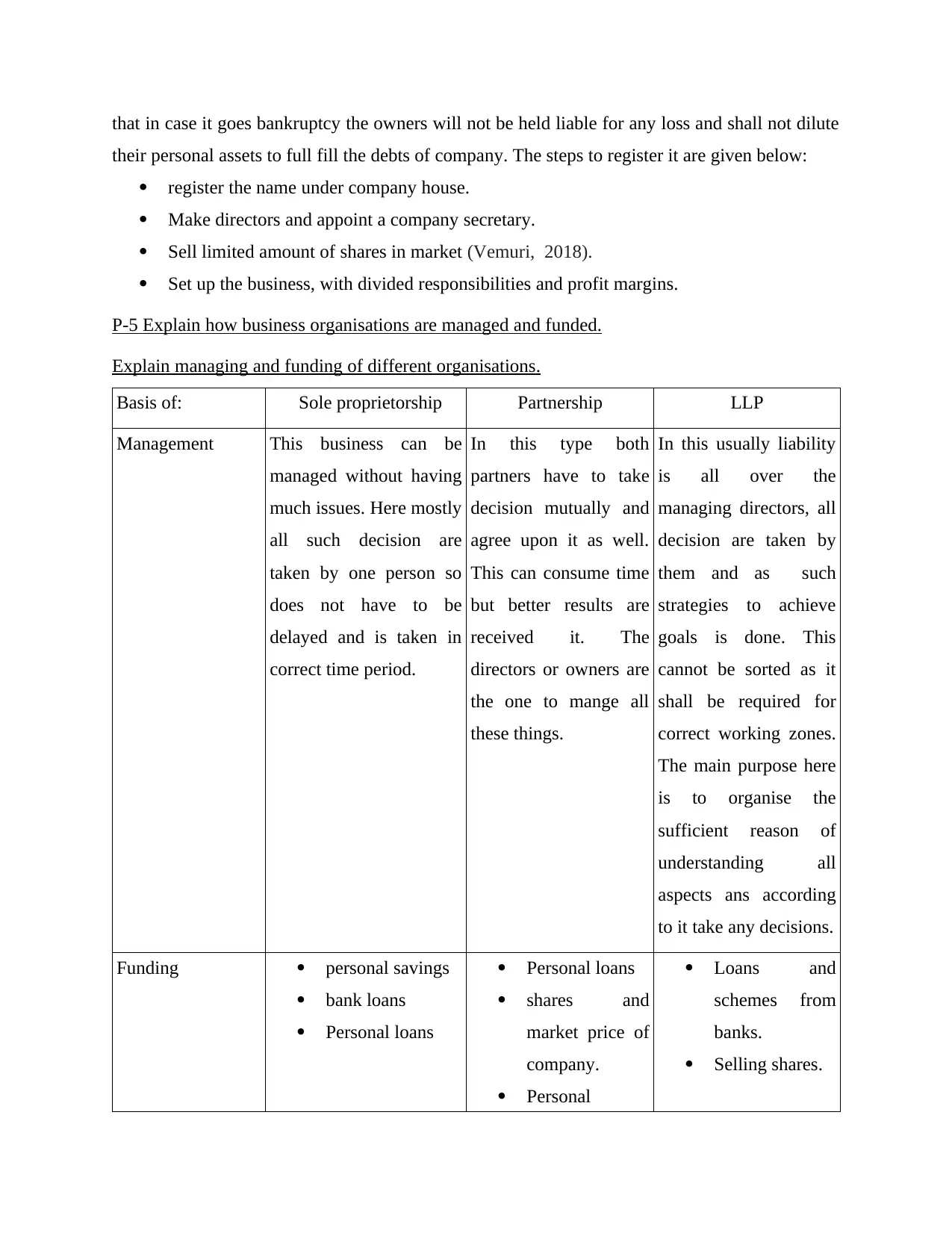
that in case it goes bankruptcy the owners will not be held liable for any loss and shall not dilute
their personal assets to full fill the debts of company. The steps to register it are given below:
register the name under company house.
Make directors and appoint a company secretary.
Sell limited amount of shares in market (Vemuri, 2018).
Set up the business, with divided responsibilities and profit margins.
P-5 Explain how business organisations are managed and funded.
Explain managing and funding of different organisations.
Basis of: Sole proprietorship Partnership LLP
Management This business can be
managed without having
much issues. Here mostly
all such decision are
taken by one person so
does not have to be
delayed and is taken in
correct time period.
In this type both
partners have to take
decision mutually and
agree upon it as well.
This can consume time
but better results are
received it. The
directors or owners are
the one to mange all
these things.
In this usually liability
is all over the
managing directors, all
decision are taken by
them and as such
strategies to achieve
goals is done. This
cannot be sorted as it
shall be required for
correct working zones.
The main purpose here
is to organise the
sufficient reason of
understanding all
aspects ans according
to it take any decisions.
Funding personal savings
bank loans
Personal loans
Personal loans
shares and
market price of
company.
Personal
Loans and
schemes from
banks.
Selling shares.
their personal assets to full fill the debts of company. The steps to register it are given below:
register the name under company house.
Make directors and appoint a company secretary.
Sell limited amount of shares in market (Vemuri, 2018).
Set up the business, with divided responsibilities and profit margins.
P-5 Explain how business organisations are managed and funded.
Explain managing and funding of different organisations.
Basis of: Sole proprietorship Partnership LLP
Management This business can be
managed without having
much issues. Here mostly
all such decision are
taken by one person so
does not have to be
delayed and is taken in
correct time period.
In this type both
partners have to take
decision mutually and
agree upon it as well.
This can consume time
but better results are
received it. The
directors or owners are
the one to mange all
these things.
In this usually liability
is all over the
managing directors, all
decision are taken by
them and as such
strategies to achieve
goals is done. This
cannot be sorted as it
shall be required for
correct working zones.
The main purpose here
is to organise the
sufficient reason of
understanding all
aspects ans according
to it take any decisions.
Funding personal savings
bank loans
Personal loans
Personal loans
shares and
market price of
company.
Personal
Loans and
schemes from
banks.
Selling shares.
⊘ This is a preview!⊘
Do you want full access?
Subscribe today to unlock all pages.

Trusted by 1+ million students worldwide
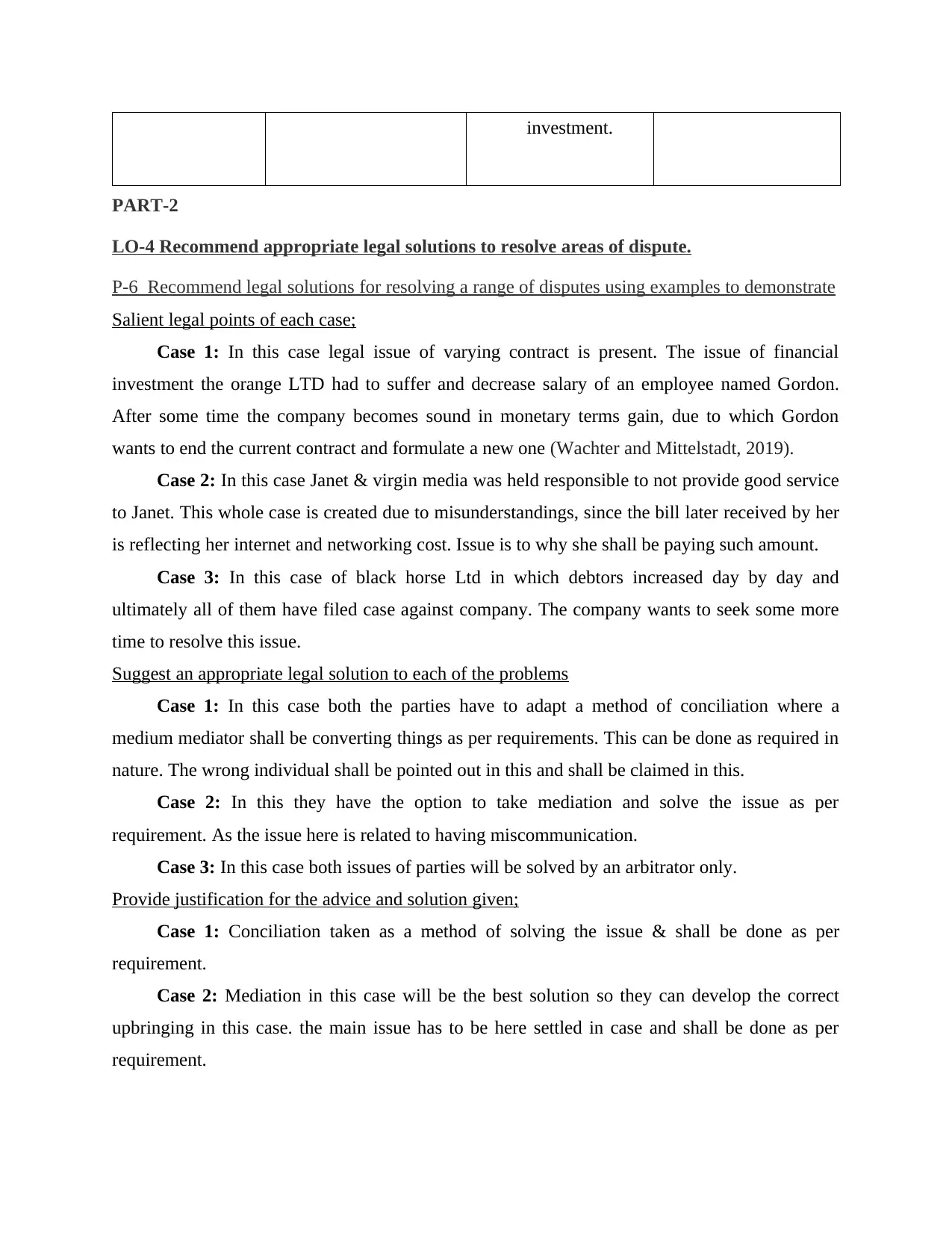
investment.
PART-2
LO-4 Recommend appropriate legal solutions to resolve areas of dispute.
P-6 Recommend legal solutions for resolving a range of disputes using examples to demonstrate
Salient legal points of each case;
Case 1: In this case legal issue of varying contract is present. The issue of financial
investment the orange LTD had to suffer and decrease salary of an employee named Gordon.
After some time the company becomes sound in monetary terms gain, due to which Gordon
wants to end the current contract and formulate a new one (Wachter and Mittelstadt, 2019).
Case 2: In this case Janet & virgin media was held responsible to not provide good service
to Janet. This whole case is created due to misunderstandings, since the bill later received by her
is reflecting her internet and networking cost. Issue is to why she shall be paying such amount.
Case 3: In this case of black horse Ltd in which debtors increased day by day and
ultimately all of them have filed case against company. The company wants to seek some more
time to resolve this issue.
Suggest an appropriate legal solution to each of the problems
Case 1: In this case both the parties have to adapt a method of conciliation where a
medium mediator shall be converting things as per requirements. This can be done as required in
nature. The wrong individual shall be pointed out in this and shall be claimed in this.
Case 2: In this they have the option to take mediation and solve the issue as per
requirement. As the issue here is related to having miscommunication.
Case 3: In this case both issues of parties will be solved by an arbitrator only.
Provide justification for the advice and solution given;
Case 1: Conciliation taken as a method of solving the issue & shall be done as per
requirement.
Case 2: Mediation in this case will be the best solution so they can develop the correct
upbringing in this case. the main issue has to be here settled in case and shall be done as per
requirement.
PART-2
LO-4 Recommend appropriate legal solutions to resolve areas of dispute.
P-6 Recommend legal solutions for resolving a range of disputes using examples to demonstrate
Salient legal points of each case;
Case 1: In this case legal issue of varying contract is present. The issue of financial
investment the orange LTD had to suffer and decrease salary of an employee named Gordon.
After some time the company becomes sound in monetary terms gain, due to which Gordon
wants to end the current contract and formulate a new one (Wachter and Mittelstadt, 2019).
Case 2: In this case Janet & virgin media was held responsible to not provide good service
to Janet. This whole case is created due to misunderstandings, since the bill later received by her
is reflecting her internet and networking cost. Issue is to why she shall be paying such amount.
Case 3: In this case of black horse Ltd in which debtors increased day by day and
ultimately all of them have filed case against company. The company wants to seek some more
time to resolve this issue.
Suggest an appropriate legal solution to each of the problems
Case 1: In this case both the parties have to adapt a method of conciliation where a
medium mediator shall be converting things as per requirements. This can be done as required in
nature. The wrong individual shall be pointed out in this and shall be claimed in this.
Case 2: In this they have the option to take mediation and solve the issue as per
requirement. As the issue here is related to having miscommunication.
Case 3: In this case both issues of parties will be solved by an arbitrator only.
Provide justification for the advice and solution given;
Case 1: Conciliation taken as a method of solving the issue & shall be done as per
requirement.
Case 2: Mediation in this case will be the best solution so they can develop the correct
upbringing in this case. the main issue has to be here settled in case and shall be done as per
requirement.
Paraphrase This Document
Need a fresh take? Get an instant paraphrase of this document with our AI Paraphraser
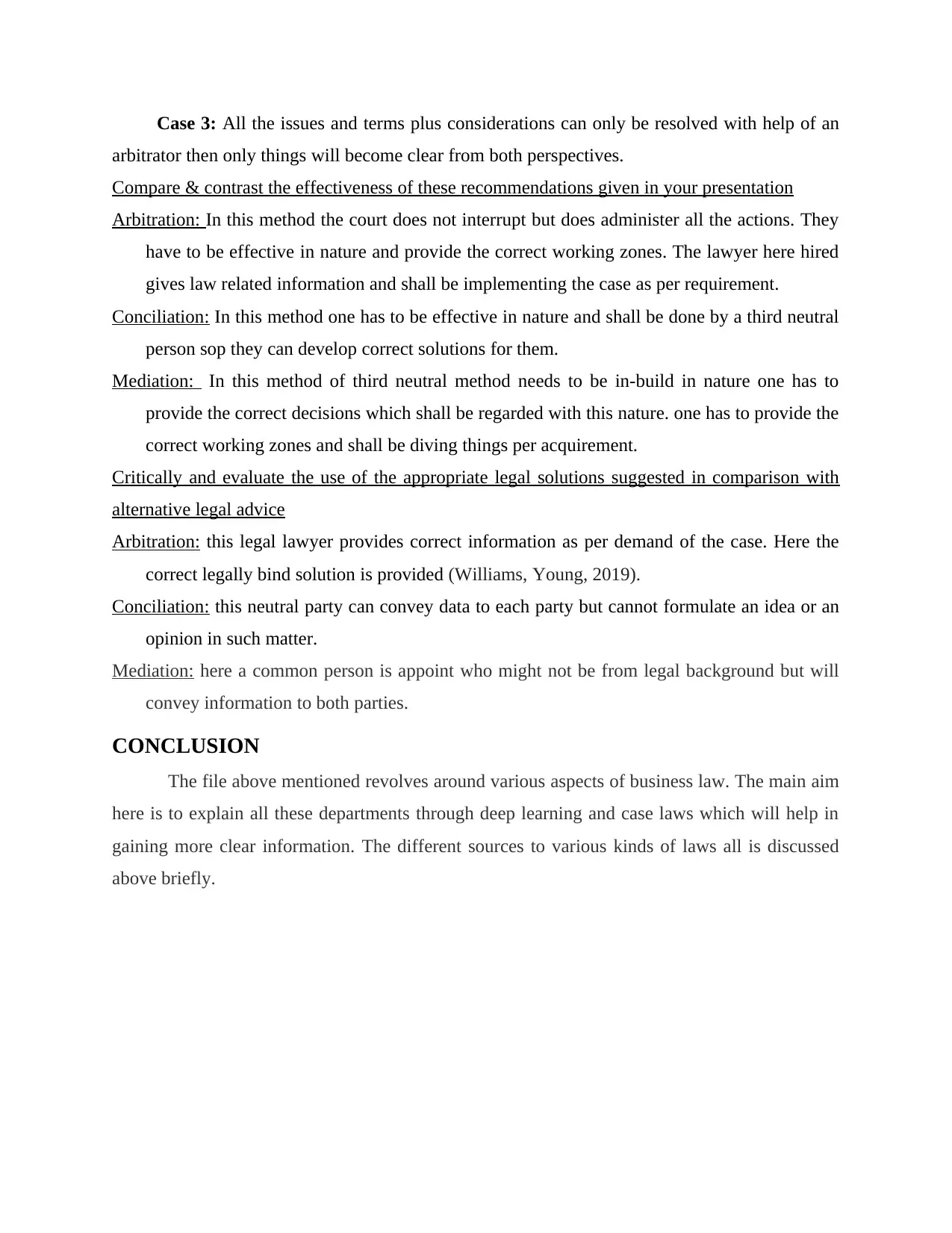
Case 3: All the issues and terms plus considerations can only be resolved with help of an
arbitrator then only things will become clear from both perspectives.
Compare & contrast the effectiveness of these recommendations given in your presentation
Arbitration: In this method the court does not interrupt but does administer all the actions. They
have to be effective in nature and provide the correct working zones. The lawyer here hired
gives law related information and shall be implementing the case as per requirement.
Conciliation: In this method one has to be effective in nature and shall be done by a third neutral
person sop they can develop correct solutions for them.
Mediation: In this method of third neutral method needs to be in-build in nature one has to
provide the correct decisions which shall be regarded with this nature. one has to provide the
correct working zones and shall be diving things per acquirement.
Critically and evaluate the use of the appropriate legal solutions suggested in comparison with
alternative legal advice
Arbitration: this legal lawyer provides correct information as per demand of the case. Here the
correct legally bind solution is provided (Williams, Young, 2019).
Conciliation: this neutral party can convey data to each party but cannot formulate an idea or an
opinion in such matter.
Mediation: here a common person is appoint who might not be from legal background but will
convey information to both parties.
CONCLUSION
The file above mentioned revolves around various aspects of business law. The main aim
here is to explain all these departments through deep learning and case laws which will help in
gaining more clear information. The different sources to various kinds of laws all is discussed
above briefly.
arbitrator then only things will become clear from both perspectives.
Compare & contrast the effectiveness of these recommendations given in your presentation
Arbitration: In this method the court does not interrupt but does administer all the actions. They
have to be effective in nature and provide the correct working zones. The lawyer here hired
gives law related information and shall be implementing the case as per requirement.
Conciliation: In this method one has to be effective in nature and shall be done by a third neutral
person sop they can develop correct solutions for them.
Mediation: In this method of third neutral method needs to be in-build in nature one has to
provide the correct decisions which shall be regarded with this nature. one has to provide the
correct working zones and shall be diving things per acquirement.
Critically and evaluate the use of the appropriate legal solutions suggested in comparison with
alternative legal advice
Arbitration: this legal lawyer provides correct information as per demand of the case. Here the
correct legally bind solution is provided (Williams, Young, 2019).
Conciliation: this neutral party can convey data to each party but cannot formulate an idea or an
opinion in such matter.
Mediation: here a common person is appoint who might not be from legal background but will
convey information to both parties.
CONCLUSION
The file above mentioned revolves around various aspects of business law. The main aim
here is to explain all these departments through deep learning and case laws which will help in
gaining more clear information. The different sources to various kinds of laws all is discussed
above briefly.
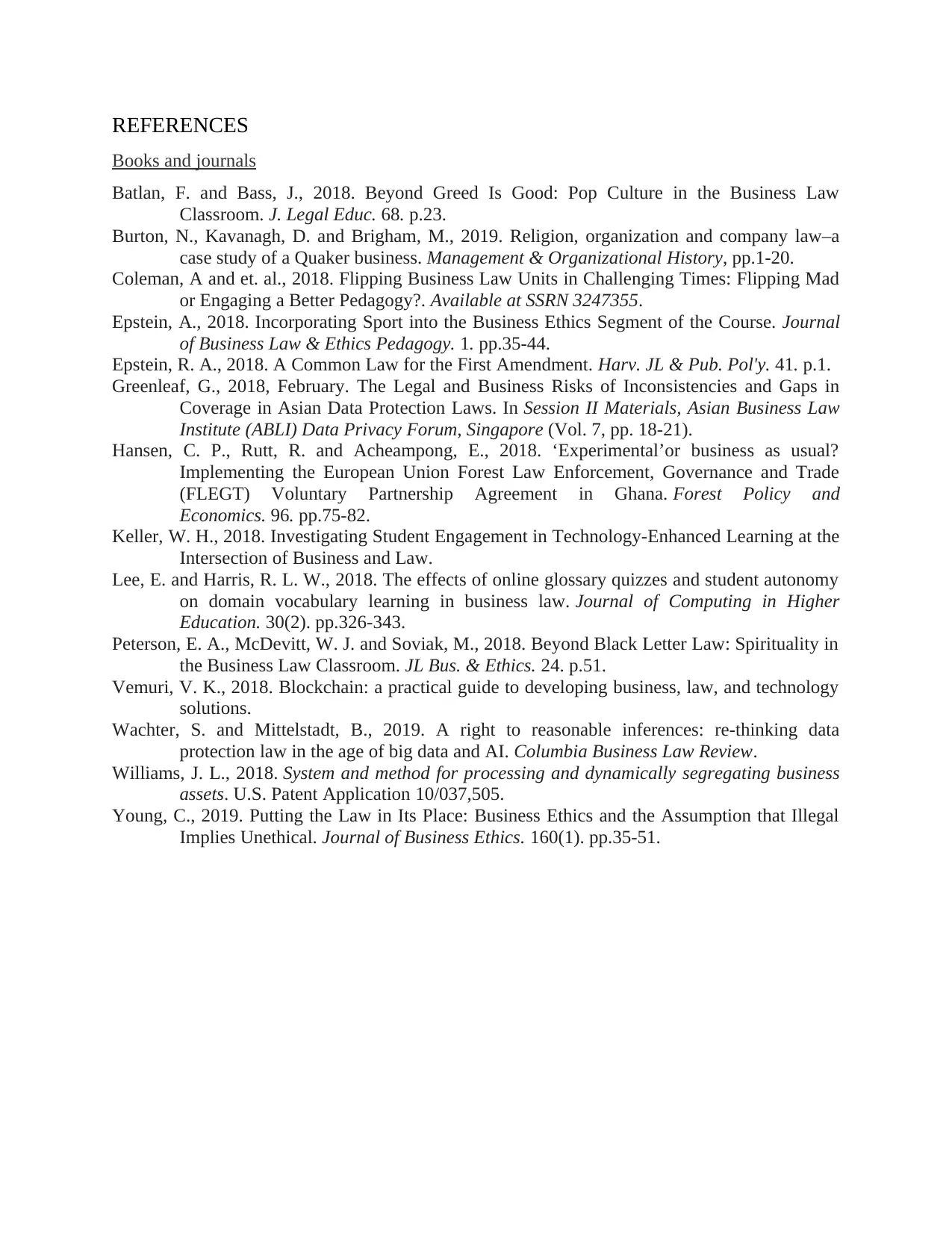
REFERENCES
Books and journals
Batlan, F. and Bass, J., 2018. Beyond Greed Is Good: Pop Culture in the Business Law
Classroom. J. Legal Educ. 68. p.23.
Burton, N., Kavanagh, D. and Brigham, M., 2019. Religion, organization and company law–a
case study of a Quaker business. Management & Organizational History, pp.1-20.
Coleman, A and et. al., 2018. Flipping Business Law Units in Challenging Times: Flipping Mad
or Engaging a Better Pedagogy?. Available at SSRN 3247355.
Epstein, A., 2018. Incorporating Sport into the Business Ethics Segment of the Course. Journal
of Business Law & Ethics Pedagogy. 1. pp.35-44.
Epstein, R. A., 2018. A Common Law for the First Amendment. Harv. JL & Pub. Pol'y. 41. p.1.
Greenleaf, G., 2018, February. The Legal and Business Risks of Inconsistencies and Gaps in
Coverage in Asian Data Protection Laws. In Session II Materials, Asian Business Law
Institute (ABLI) Data Privacy Forum, Singapore (Vol. 7, pp. 18-21).
Hansen, C. P., Rutt, R. and Acheampong, E., 2018. ‘Experimental’or business as usual?
Implementing the European Union Forest Law Enforcement, Governance and Trade
(FLEGT) Voluntary Partnership Agreement in Ghana. Forest Policy and
Economics. 96. pp.75-82.
Keller, W. H., 2018. Investigating Student Engagement in Technology-Enhanced Learning at the
Intersection of Business and Law.
Lee, E. and Harris, R. L. W., 2018. The effects of online glossary quizzes and student autonomy
on domain vocabulary learning in business law. Journal of Computing in Higher
Education. 30(2). pp.326-343.
Peterson, E. A., McDevitt, W. J. and Soviak, M., 2018. Beyond Black Letter Law: Spirituality in
the Business Law Classroom. JL Bus. & Ethics. 24. p.51.
Vemuri, V. K., 2018. Blockchain: a practical guide to developing business, law, and technology
solutions.
Wachter, S. and Mittelstadt, B., 2019. A right to reasonable inferences: re-thinking data
protection law in the age of big data and AI. Columbia Business Law Review.
Williams, J. L., 2018. System and method for processing and dynamically segregating business
assets. U.S. Patent Application 10/037,505.
Young, C., 2019. Putting the Law in Its Place: Business Ethics and the Assumption that Illegal
Implies Unethical. Journal of Business Ethics. 160(1). pp.35-51.
Books and journals
Batlan, F. and Bass, J., 2018. Beyond Greed Is Good: Pop Culture in the Business Law
Classroom. J. Legal Educ. 68. p.23.
Burton, N., Kavanagh, D. and Brigham, M., 2019. Religion, organization and company law–a
case study of a Quaker business. Management & Organizational History, pp.1-20.
Coleman, A and et. al., 2018. Flipping Business Law Units in Challenging Times: Flipping Mad
or Engaging a Better Pedagogy?. Available at SSRN 3247355.
Epstein, A., 2018. Incorporating Sport into the Business Ethics Segment of the Course. Journal
of Business Law & Ethics Pedagogy. 1. pp.35-44.
Epstein, R. A., 2018. A Common Law for the First Amendment. Harv. JL & Pub. Pol'y. 41. p.1.
Greenleaf, G., 2018, February. The Legal and Business Risks of Inconsistencies and Gaps in
Coverage in Asian Data Protection Laws. In Session II Materials, Asian Business Law
Institute (ABLI) Data Privacy Forum, Singapore (Vol. 7, pp. 18-21).
Hansen, C. P., Rutt, R. and Acheampong, E., 2018. ‘Experimental’or business as usual?
Implementing the European Union Forest Law Enforcement, Governance and Trade
(FLEGT) Voluntary Partnership Agreement in Ghana. Forest Policy and
Economics. 96. pp.75-82.
Keller, W. H., 2018. Investigating Student Engagement in Technology-Enhanced Learning at the
Intersection of Business and Law.
Lee, E. and Harris, R. L. W., 2018. The effects of online glossary quizzes and student autonomy
on domain vocabulary learning in business law. Journal of Computing in Higher
Education. 30(2). pp.326-343.
Peterson, E. A., McDevitt, W. J. and Soviak, M., 2018. Beyond Black Letter Law: Spirituality in
the Business Law Classroom. JL Bus. & Ethics. 24. p.51.
Vemuri, V. K., 2018. Blockchain: a practical guide to developing business, law, and technology
solutions.
Wachter, S. and Mittelstadt, B., 2019. A right to reasonable inferences: re-thinking data
protection law in the age of big data and AI. Columbia Business Law Review.
Williams, J. L., 2018. System and method for processing and dynamically segregating business
assets. U.S. Patent Application 10/037,505.
Young, C., 2019. Putting the Law in Its Place: Business Ethics and the Assumption that Illegal
Implies Unethical. Journal of Business Ethics. 160(1). pp.35-51.
⊘ This is a preview!⊘
Do you want full access?
Subscribe today to unlock all pages.

Trusted by 1+ million students worldwide
1 out of 12
Related Documents
Your All-in-One AI-Powered Toolkit for Academic Success.
+13062052269
info@desklib.com
Available 24*7 on WhatsApp / Email
![[object Object]](/_next/static/media/star-bottom.7253800d.svg)
Unlock your academic potential
Copyright © 2020–2025 A2Z Services. All Rights Reserved. Developed and managed by ZUCOL.




